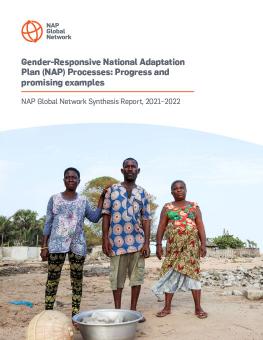
Gender-Responsive National Adaptation Plan (NAP) Processes: Progress and promising examples
The progress shown in this report demonstrates the potential of NAP processes as a mechanism for ensuring that climate action addresses gender and social inequalities.
-
97% of developing countries that have submitted a National Adaptation Plan (NAP) to the UNFCCC are integrating gender considerations into their NAP documents. This demonstrates a growing awareness among national governments that climate action must be gender responsive.
-
Almost one-third of all NAPs (29%) now refer to gender responsiveness, whereas in 2018, none of them did.
-
Approximately 50% of NAPs now recognize that women can act as agents of change in the adaptation planning process. The inclusion of women in NAP processes and the recognition of their lived experiences can strengthen the outcomes of adaptation actions.
This document is the third in a series of synthesis reports that assess progress on gender-responsive approaches in National Adaptation Plan (NAP) processes at the global level. It coincides with the midpoint of the Gender Action Plan under the United Nations Framework Convention on Climate Change (UNFCCC), making this a good moment to reflect on progress in integrating gender considerations in NAP processes.
We explore this through a systematic review of the NAP documents submitted to the UNFCCC, as well as through practical examples that illustrate how countries are taking a gender-responsive approach to their NAP processes.
As countries increasingly move from planning to implementation of adaptation actions, more opportunities are created to work with diverse stakeholders to build resilience while also creating more equitable communities and societies.
You might also be interested in
Learning From Gender-Responsive National Adaptation Plan Processes: Insights from countries to inform the review of the UNFCCC Gender Action Plan
Based on the priority actions of 10 African and Caribbean countries for integrating gender equality in their National Adaptation Plan (NAP) processes, we identified recommendations for effectively advancing the Gender Action Plan (GAP) under the United Nations Framework Convention on Climate Change (UNFCCC).
Putting Equity at the Heart of the Global Stocktake
Capturing the world's collective progress towards achieving the Paris Agreement goals requires a look at who is being left behind and what we must do to create an equitable, climate-resilient future for all.
Envisioning Resilience: Bringing underrepresented women's voices into planning for climate change adaptation
Meaningful participation by women who are on the front lines of climate change is essential for gender-responsive, locally led adaptation. However, in many contexts, women remain underrepresented in decision making, from local to national levels.
Earth Today | Gender and climate change group
Clehan Williams (left), adviser to Senator Matthew Samuda, minister without Portfolio in the Ministry of Economic Growth & Job Creation, joins representatives of the team that developed Jamaica’s Gender and Climate Change Strategy and Action Plan at the recent unveiling of the document. From second left are: Consultant gender specialists Anika Grey and Indi McLymont-Lafayette; Dr Orville Grey, regional manager, Caribbean, at the Green Climate Fund; Angie Dazé, gender equality and social inclusion lead at the International Institute for Sustainable Development (IISD); Sharon Coburn Robinson, principal director at the Bureau of Gender Affairs; Catherine Senecal, programme manager, resilience at IISD; and Omar Alcock, senior technical officer (mitigation) at the Climate Change Division.